The Pursuit of Beauty
by Bob Brooke
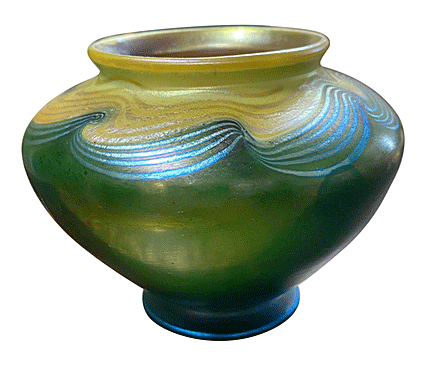 Louis
Comfort Tiffany was a very special person. He not only worked with
glass, he had a relationship with it. He didn’t just create art
glass, he actually created the type of glass—favrille—that he used
to create his pieces. Louis
Comfort Tiffany was a very special person. He not only worked with
glass, he had a relationship with it. He didn’t just create art
glass, he actually created the type of glass—favrille—that he used
to create his pieces.
By the time Louis Comfort Tiffany had been born in 1848, his father,
Charles Louis Tiffany, had established himself as a jeweler and
silversmith, founding the firm of Tiffany & Young in 1837. By the
year 1870, his father's was the smartest shop in the country and was
able to present for sale what was possibly the largest collection of
gems in the world. The firm's own silverware was of a very high
standard and had won prizes in European exhibitions, including the
Paris Exhibition of 1867.
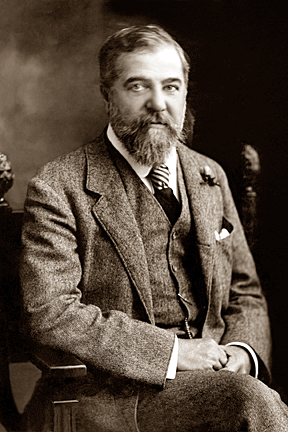 The
young Tiffany took little interest in his father’s business and
seemed to have no enthusiasm for the commercial side of it. In 1866,
he decided to study art rather than go to college. He first leaned
towards landscape painting and developed a romantic view of nature
as the pupil of one of America's leading landscape artists, George
Inness. Tiffany spent the winter of 1868/1869 in Paris with Leon
Bailly, who took Tiffany on a visit to Spain and North Africa,
instilling in him a fascination for Islamic and Moorish art, the
styles of which he adapted in his eclectic decorative schemes. The
young Tiffany took little interest in his father’s business and
seemed to have no enthusiasm for the commercial side of it. In 1866,
he decided to study art rather than go to college. He first leaned
towards landscape painting and developed a romantic view of nature
as the pupil of one of America's leading landscape artists, George
Inness. Tiffany spent the winter of 1868/1869 in Paris with Leon
Bailly, who took Tiffany on a visit to Spain and North Africa,
instilling in him a fascination for Islamic and Moorish art, the
styles of which he adapted in his eclectic decorative schemes.
Unfortunately, Tiffany wasn’t very good at painting, so he decided
devote his work to the applied arts and interior decoration. In
1879, he formed a partnership with Samuel Colman and Candace
Wheeler, which he called Louis C. Tiffany and Associated Artists.
He quickly gained an excellent reputation, and his pre-eminence as
America's leading interior decorator. In the winter of 1882/1883,
the White House invited him to redecorate parts of it.
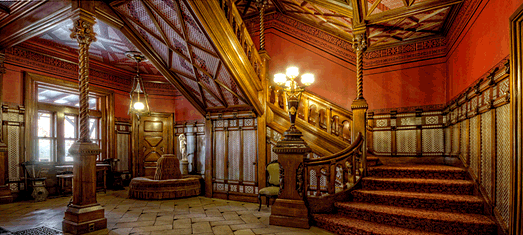
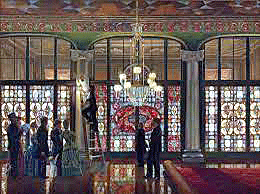 The
Associated Artists decorative work was essentially high Victorian with a
sense of harmony, blending Islamic art with their own embroidered
hangings and painted friezes and with tiling and paneling in the colored
glass in which Tiffany was becoming interested. The
Associated Artists decorative work was essentially high Victorian with a
sense of harmony, blending Islamic art with their own embroidered
hangings and painted friezes and with tiling and paneling in the colored
glass in which Tiffany was becoming interested.
He became interested in the domestic applications of glass, so he
decided to break from the Associated Artists and focus on glassmaking.
During his travels, Tiffany had formed a collection of glass — his
particular fascination was with ancient glass with its marvelous
nacreous iridescence, caused by decomposition while buried, and by the
effects of metallic oxides. Tiffany also loved the pitted and corroded
effects caused by decomposition. He saw the beauty of what were
essentially imperfections in the glass. It became his ambition to learn
so much about glass and its reactions to different types of chemicals
that he would be able to control these accidental imperfections.
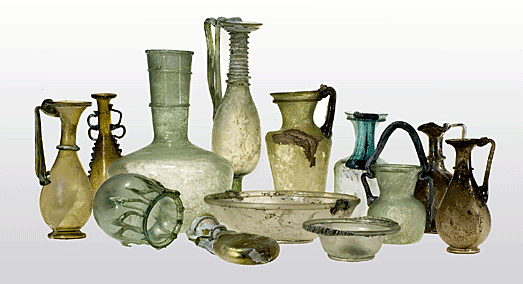
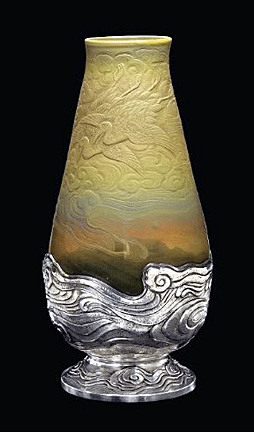 Colored
glass fascinated him. The art of stained-glass windows was a challenge
he couldn’t resist, but he was horrified by those craftsmen who were
content to apply painted decoration to the glass. Tiffany felt most
strongly that any decoration in his glasswork should be integral to the
glass body. If, for instance, he wanted a glass vase to be decorated
with flowers, he felt their presence should be represented by the
texture and the color of the glass itself rather than just painting them
on. Colored
glass fascinated him. The art of stained-glass windows was a challenge
he couldn’t resist, but he was horrified by those craftsmen who were
content to apply painted decoration to the glass. Tiffany felt most
strongly that any decoration in his glasswork should be integral to the
glass body. If, for instance, he wanted a glass vase to be decorated
with flowers, he felt their presence should be represented by the
texture and the color of the glass itself rather than just painting them
on.
Tiffany was further inspired by the simplicity of the forms of ancient
glass, just as he was horrified by 19th-century efforts to mold or cut
glass into shapes more appropriate for bronze or porcelain. The
irregularity of form of ancient glass awed him and, as a result, his own
glassware had a certain asymmetry.
Tiffany didn’t produce all the glass that bears his name, although he
kept a close supervision on everything that left his workshops. And
though he experimented intensively with different types of glass, most
of his output was of commercial quality, for he had a very large and
enthusiastic clientele.
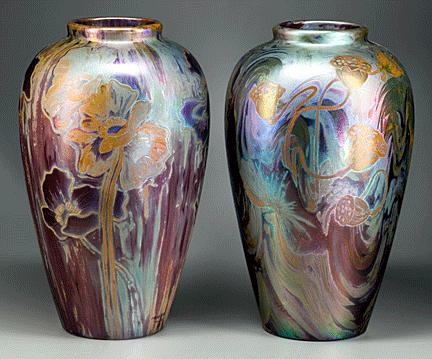 He
kept the market happy with the plain gold luster pieces—vases, sets of
beakers, glasses, tazze, bowls, finger-bowls and stands---which form the
largest single category, designed mostly as decorative tableware In a
patent claim filed in 1880, Tiffany described the essential method of
producing iridescent glass as forming a film of a metal or its oxide or
a compound of the metal on or in the glass, either by exposing it to
vapors or gasses or by direct application. It may also be produced by
corroding the surface of the glass, such processes being well known to
glass manufacturers. He
kept the market happy with the plain gold luster pieces—vases, sets of
beakers, glasses, tazze, bowls, finger-bowls and stands---which form the
largest single category, designed mostly as decorative tableware In a
patent claim filed in 1880, Tiffany described the essential method of
producing iridescent glass as forming a film of a metal or its oxide or
a compound of the metal on or in the glass, either by exposing it to
vapors or gasses or by direct application. It may also be produced by
corroding the surface of the glass, such processes being well known to
glass manufacturers.
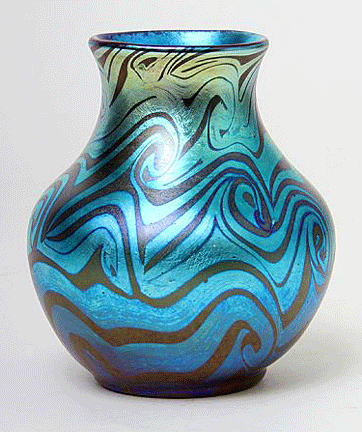 Tiffany
found how cobalt or copper oxides could color glass blue, how iron oxide
resulted in green, how manganese oxide produced shades of violet; how
gold or copper produced red, how coke, coal or other carbon oxides gave
an amber color, and how manganese cobalt and iron could combine to give
a black glass. He achieved the distinctive gold luster gold chloride
either suspended in the glass or sprayed on while the glass was still
hot from the furnace. He used $25 gold pieces as the base. After the
plain gold glass, the most frequent colors were blue, green, white,
yellow, brown, amethyst, black, and red. Tiffany
found how cobalt or copper oxides could color glass blue, how iron oxide
resulted in green, how manganese oxide produced shades of violet; how
gold or copper produced red, how coke, coal or other carbon oxides gave
an amber color, and how manganese cobalt and iron could combine to give
a black glass. He achieved the distinctive gold luster gold chloride
either suspended in the glass or sprayed on while the glass was still
hot from the furnace. He used $25 gold pieces as the base. After the
plain gold glass, the most frequent colors were blue, green, white,
yellow, brown, amethyst, black, and red.
The second most numerous category was his decorated iridescent ware,
which included all types of glass from the superb Peacock
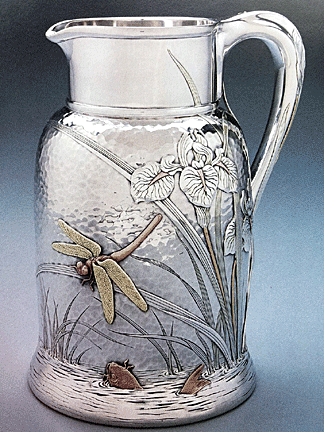 Feather
vases and the flower forms to the simpler vases decorated with a few
trailing ivy leaves or lily pads. Tiffany's Peacock Feather vases were
the ultimate achievement in this technique, and they were often further
enhanced by inlaid evil eyes of dark colored glass. Feather
vases and the flower forms to the simpler vases decorated with a few
trailing ivy leaves or lily pads. Tiffany's Peacock Feather vases were
the ultimate achievement in this technique, and they were often further
enhanced by inlaid evil eyes of dark colored glass.
Another group that presented Tiffany with technical problems was his
paperweight vases in which he trapped floral decoration between two
layers of glass. An initial form would have been blown into its warm,
soft surface would have been into pressed colored glass to form
flower-patterns. These would be rolled until smooth and the whole would
be cased in a further layer of glass, thus giving to the surface of the
object an illusion of great depth which was sometimes enhanced by a
light internal iridescence. Perhaps the finest quality paperweight vases
were those which incorporated millefiore glass in which glassblowers
sliced glass canes and then embedded them in groups in the inner layer
of glass, then rolled into the surface. These millefiore canes were
similar to ones used in traditional French paperweights, but Tiffany’s
application was all the more remarkable because he was able to create so
successfully a three-dimensional effect with so thin a body.
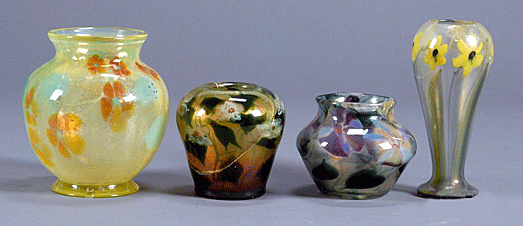
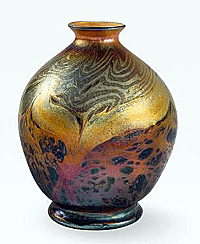 Cypriote
was the name given to a type of glass most closely inspired by the
corroded textures of excavated ancient glass. Nearly always found in
brown or blue opaque glass, Cypriote ware featured a crusty surface.
Tiffany achieved this effect by rolling the body over a marvel covered
with pulverized crumbs of glass. Cypriote pieces were often haphazard in
form and were often larger than other types of vases.. Cypriote
was the name given to a type of glass most closely inspired by the
corroded textures of excavated ancient glass. Nearly always found in
brown or blue opaque glass, Cypriote ware featured a crusty surface.
Tiffany achieved this effect by rolling the body over a marvel covered
with pulverized crumbs of glass. Cypriote pieces were often haphazard in
form and were often larger than other types of vases..
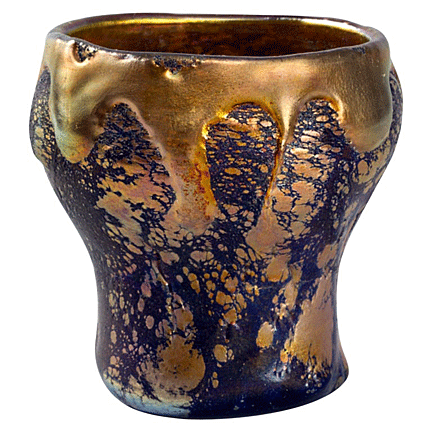 Lava
glass was generally of a dark blue luster body with voluptuous,
abstract-organic, trailed or poured, gold luster decoration. In their
'very free conception of form, they were among the most revolutionary of
Tiffany's works. Lava
glass was generally of a dark blue luster body with voluptuous,
abstract-organic, trailed or poured, gold luster decoration. In their
'very free conception of form, they were among the most revolutionary of
Tiffany's works.
There are other categories such as Agate ware—colored glasses run
together and then polished down to resemble agate—and Marbleized
ware---colors blended to resemble the texture of marble—and the various
glasses used in the series of leaded
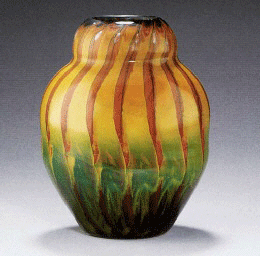 shades
for table lamps which helped more than anything else to make Tiffany's
name a household word. No well-decorated home in America was complete
without one. shades
for table lamps which helped more than anything else to make Tiffany's
name a household word. No well-decorated home in America was complete
without one.
While Louis Comfort Tiffany was no great social theorist, his influence,
however, was very great in giving an identity to American craftsmanship.
At the back of his mind was always an ambition to become a kind of
American William Morris, but he found it all too easy to indulge his
taste for the luxurious and the exotic. There was no return to
simplicity, although there was a return to nature and inspiration from
organic form.
<
Back to Caring for Your Collections
Archives Next
Article > |
